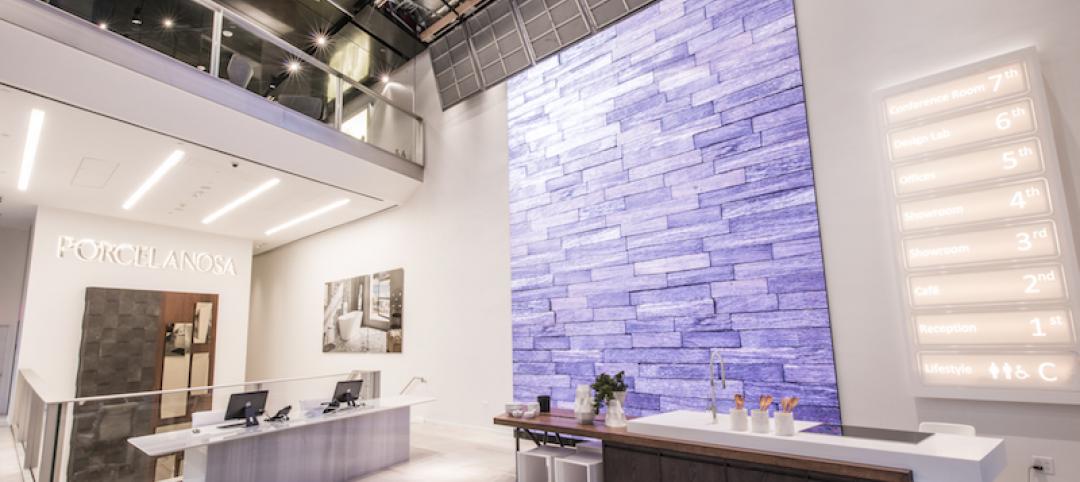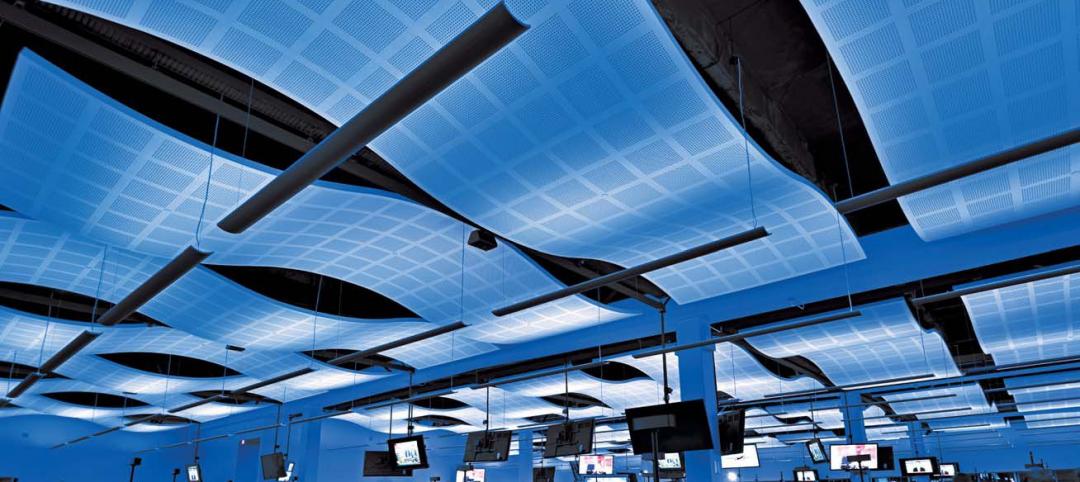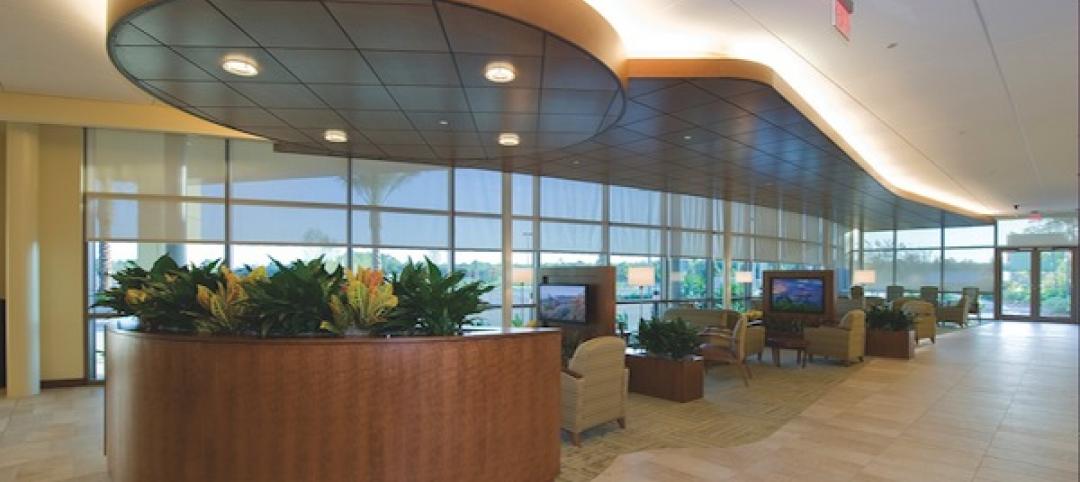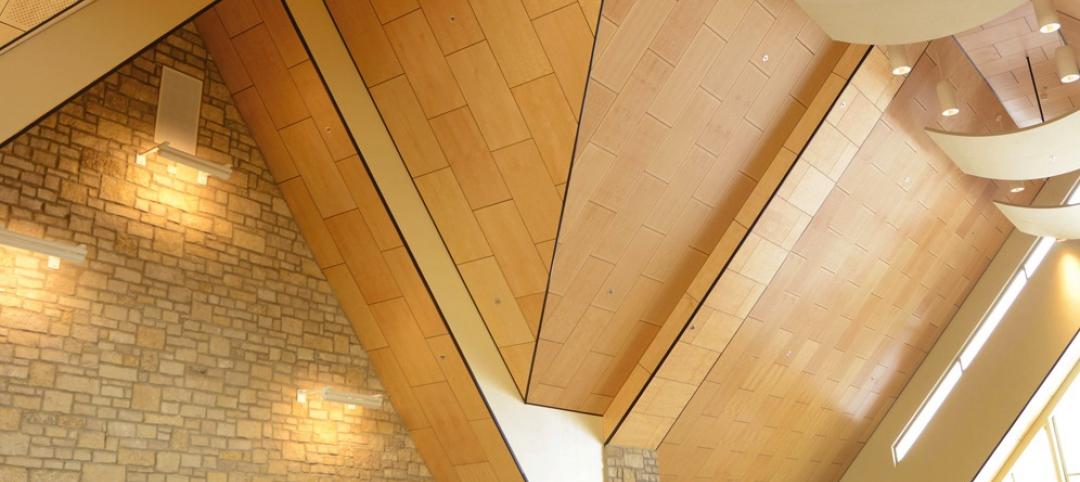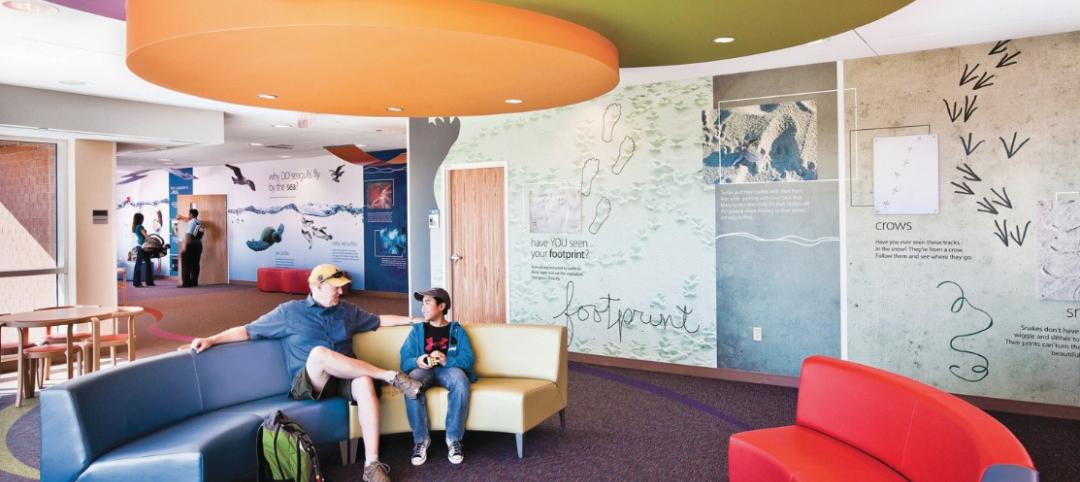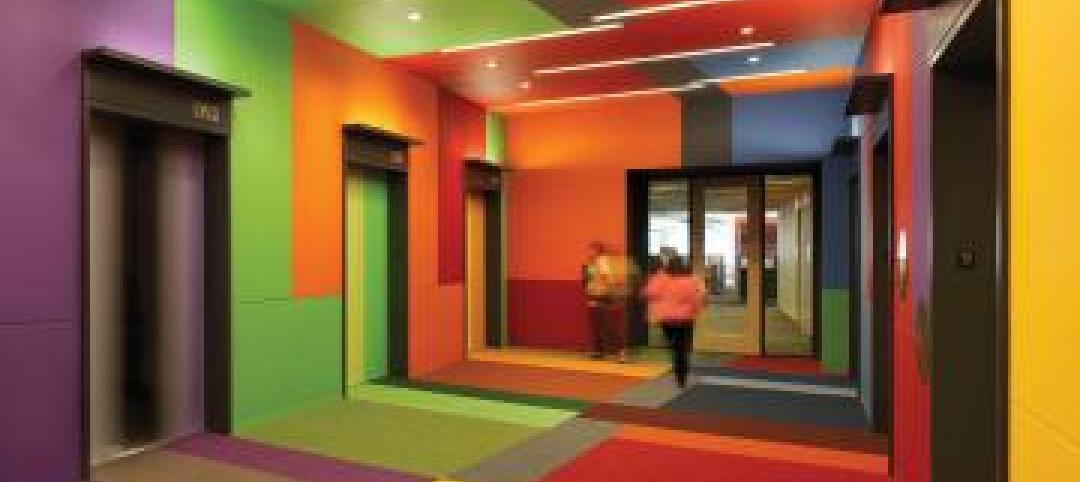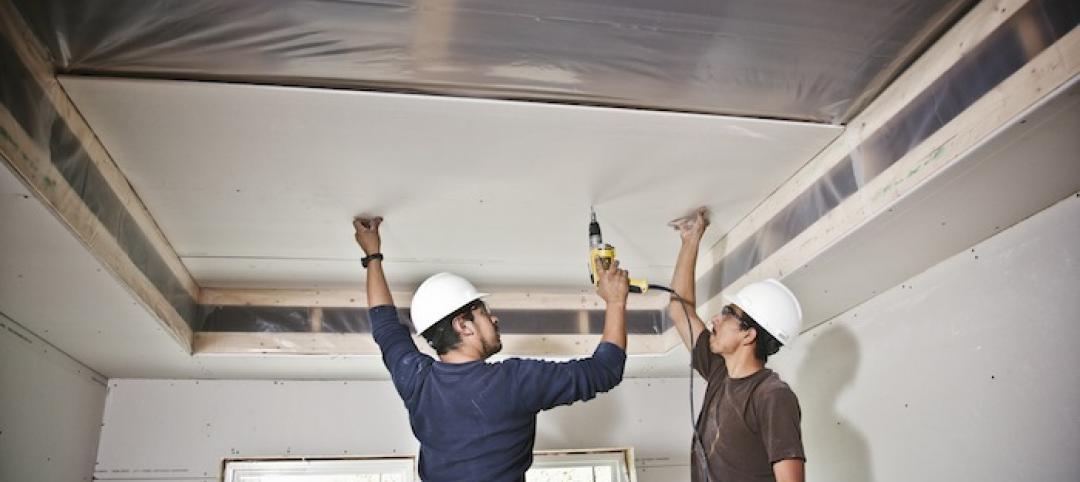The University of Toronto recently completed construction of a new addition to its School of Architecture. The top floor of the new Daniels Building features an expansive 16,000-square-foot open space designed to function as a studio and study hall. The space features no interior walls or structural columns.
Towering above the massive space is a very contemporary drywall ceiling designed to replicate wings. Hyperbolic paraboloid in shape, four angled drywall ceiling slabs gently twist from one side of the space to the other.
Creating the complex framing on which to attach the drywall was a key consideration. Project designers initially considered metal studs. However, a number of factors presented potential problems, including the overall size and twist of each ceiling surface.
According to Robert Dell’Elce, Vice President of Nelmar Drywall Company of Vaughan, Ontario, “Once we saw the initial drawings, we had our doubts it could be done with metal studs because of all the twists and turns.”
To find an alternative, the drawings were sent to Armstrong Ceiling Solutions to see if a drywall grid system was feasible. “We were familiar with drywall grid from a previous project and thought it would work here because of the flexibility it offered compared to metal studs,” he says.
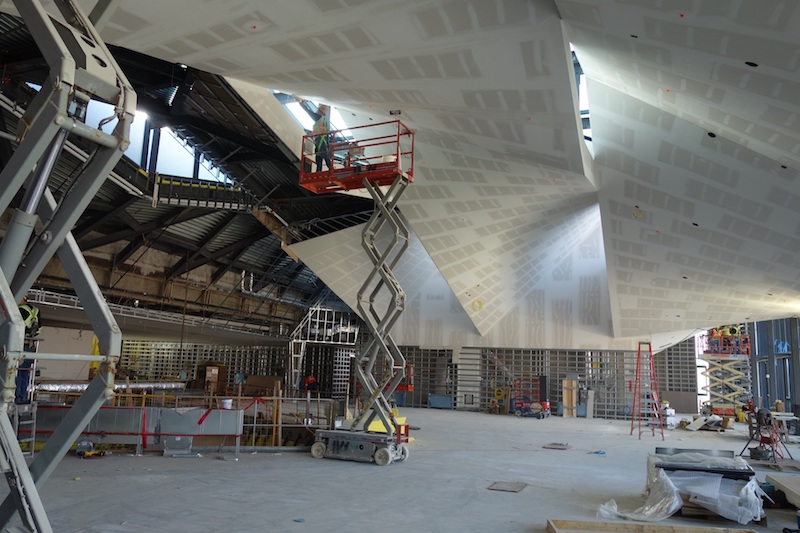 The drywall grid system maintained the curvature of the ceiling very well, even without wetting the 5/8” drywall.
The drywall grid system maintained the curvature of the ceiling very well, even without wetting the 5/8” drywall.
Full-Scale Mock-Up Created
In order to ascertain that drywall grid would perform as desired, Armstrong Ceilings created a full-scale mock-up at the local union training center. “The mock-up showed that the framing was possible using drywall grid and that gave us a level of confidence to proceed,” Dell’Elce says.
Following approval for its use, an initial challenge was the fact that this would be the first time many of the installation crews would be working with drywall grid, let alone on such an unusual shape. To remedy this, Armstrong Ceilings held on-site training sessions to help ensure a hassle-free installation. “The jobsite training we received was a huge help,” Dell’Elce states, “otherwise it could have been a nightmare.”
Foreman Chris Morgan notes that the crews learned the technique quickly since “everything essentially snaps together just like normal T-bar grid systems.” Because of the ease and speed of installation, he estimates the drywall grid system probably installed in half the time as the original steel stud system, significantly reducing labor on the project.
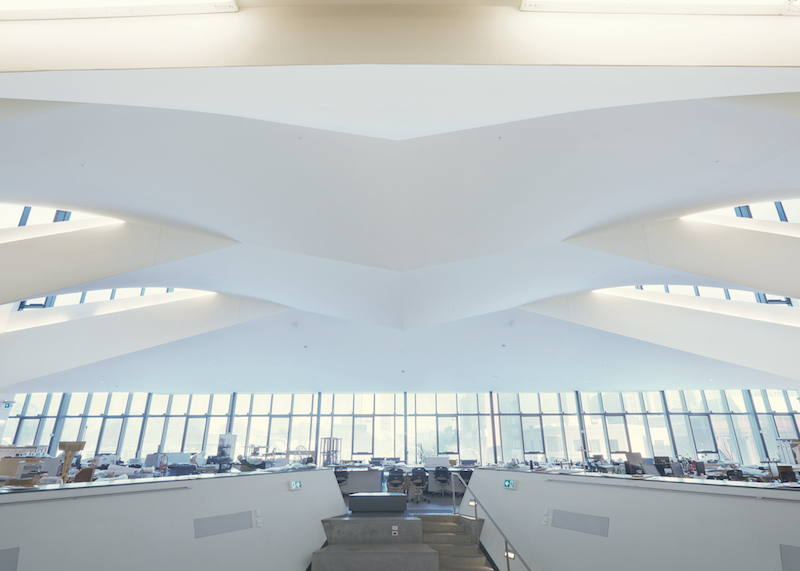
Morgan also notes that the drywall grid system maintained the smooth curvature of the ceiling very well, even with 5/8” drywall. “We were surprised how well the drywall mirrored the curve of the ceiling without having to wet it,” he states.
Looking back at the project and his first experience with a drywall grid system, Morgan states, “I would use it anytime I can now, especially in curved situations. I was amazed it worked so well.”
And as far as the future, Dell’Elce notes that the system is definitely increasing in use, stating, “Drywall grid is becoming much more common now as more and more architects become familiar with it.”
For additional information on Armstrong® Drywall Grid Systems, visit armstrongceilings.com/drywallgrid.
Related Stories
Great Solutions | Jan 20, 2016
Porcelanosa’s solid-surface product, Krion, used to create an elegant retractable ceiling for NY showroom
Typically used for countertops, vanities, and furniture, Krion was used to make 39 panels covering 1,300 sf of ceiling space above the showroom.
Ceilings | Mar 25, 2015
7 sleek selections for ceilings and acoustical systems
Thermoformed ceilings, acoustic panels, sound isolation membrane, and undulating ceiling systems are featured in this roundup of breakthrough products.
| Dec 28, 2014
New trends in ceiling designs and materials [AIA course]
A broad array of new and improved ceiling products offers designers everything from superior acoustics and closed-loop, recycled content to eased integration with lighting systems, HVAC diffusers, fire sprinkler heads, and other overhead problems. This course describes how Building Teams are exploring ways to go beyond the treatment of ceilings as white, monolithic planes.
| Sep 22, 2014
Sound selections: 12 great choices for ceilings and acoustical walls
From metal mesh panels to concealed-suspension ceilings, here's our roundup of the latest acoustical ceiling and wall products.
| Jun 12, 2014
Austrian university develops 'inflatable' concrete dome method
Constructing a concrete dome is a costly process, but this may change soon. A team from the Vienna University of Technology has developed a method that allows concrete domes to form with the use of air and steel cables instead of expensive, timber supporting structures.
| Oct 4, 2013
ROCKWOOL Group of Denmark acquires Chicago Metallic
The ROCKWOOL Group, on behalf of its ROCKFON® Group affiliate, a supplier of stone wool acoustic ceiling and wall solutions, has acquired Chicago Metallic, a global provider of architectural building products and services -- including metal panels and ceiling systems, suspended grid systems, and acoustical and sustainable ceiling panels.
| Sep 16, 2013
Study analyzes effectiveness of reflective ceilings
Engineers at Brinjac quantify the illuminance and energy consumption levels achieved by increasing the ceiling’s light reflectance.
| Sep 9, 2013
Top 25 continuing education courses on BDCuniversity
An overview of the 25 most popular continuing education courses on BDCuniversity.com.
| Mar 29, 2013
Sheetrock Brand UltraLight Panels first and only ICC ES compliant panel for ceilings
USG Corporation, a leading building products company and the industry innovator in lightweight drywall, is pleased to announce that its award-winning SHEETROCK® UltraLight Panels are now ICC Evaluation Services compliant for installation on ceilings with the long edges parallel to the framing.
| Feb 28, 2013
Lend Lease builds world's tallest timber apartment building
Construction giant Lend Lease recently put the finishing touches on Forté, a 10-story apartment complex in Melbourne, Australia's Victoria Harbour that was built entirely with cross laminated timber (CTL) technology.


